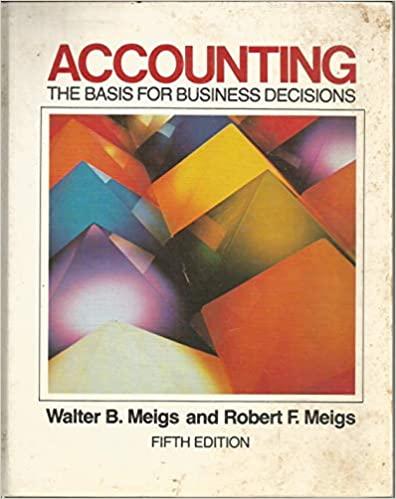Question
1. Reasonable in amount means that expenditures cannot be exorbitant even if the amount is motivated by profit. true or false 2. Expenses associated with
1. Reasonable in amount means that expenditures cannot be exorbitant even if the amount is motivated by profit.
true or false
2. Expenses associated with illegal activities are not deductible but speeding fines can be deducted as long as the speeding was done in the line of business.
true or false
3. The cost of a business meal is deductible only if the meal is associated with the active conduct of rent/royalty business.
true or false
4. The domestic manufacturing deduction cannot exceed 50 percent of the wages paid to employees engaged in domestic manufacturing activities during the year.
true or false
5. A short year can only end on the first day of any month.
true or false
6. The all-events test for income determines the amount of income will be included in taxable income for accrual method taxpayers.
true or false
7. The full-inclusion method requires accrual method taxpayers to include prepayments for goods or services into realized income.
true or false
8. The arm's length transaction test would most likely not apply to which of the following?
true or false
9. Which of the following is a true statement?
a. The cost of business entertainment must be reasonable in amount.
b. An employer can only deduct half of any meals provided to employees.
c. Meals are fully deductible as a business expense if incurred to entertain clients.
d. A taxpayer can only deduct the full cost of a meal for a client if business is discussed after the meal.
e. none of these choices are true
10. Which of the following is a true statement?
- The cost of transportation is always deductible for travel that has both business and personal aspects.
- Employees can deduct the cost of meals when they must work during the lunch hour.
- Half of the costs of travel are deductible for employees who travel on business.
- The cost of lodging is deductible if the taxpayer is away from home overnight on business.
-
None of the choices are true
11. Drake operates a trucking business, and one of his trucks was damaged in a traffic accident. The truck was purchased for $52,000 and the adjusted basis was $22,000 at the time of the accident. The truck was repaired at a cost of $5,000 and insurance reimbursed Drake $2,000 of this cost. What is the amount of Drakes casualty loss deduction?
a. 22,000
b.5,000
c.3,000
d. 2,000
e. drake is not eligible for casualty loss deduction
12. Which of the following cannot be selected as a valid tax year end?
a. dec 15th
b. jan 31
c. the last friday of the last week of june
d. dec 31
e. a tax payer can select any of these days as a year end
13. Charles operates a sole proprietorship using the cash method. This year Charles paid $6,400 to the bank for 12 months of interest accruing on a business loan from July 1st of this year through June 30 of next year and $6,000 for 12 months of property insurance beginning on July 1st of this year. What is the maximum amount Charles can deduct this year?
a. 12,400
b. 9,200
c. 6,400
d. 6,000
e. 6,200
14. Steven operates a landscaping service on the accrual method. In September of this year Steven received a payment of $18,000 for 24 months of landscape services ($750 per month commencing on November 1st of this year). When must Steven recognize the income if his accounting methods are selected to minimize income recognition?
a. 1,500 is recognized in this year, 16,500 next year
b. 1,500 is recognized this year, $9000 next year, and $7500 in the last year of the contract
c. 18000 is recognized this year
d. 9000 is recognized this year and 9000 next year
e. 18000 is recognized in the last year of the contract
15. Which of the following is not a payment liability?
a. tort claims,
b. accured compensation
c. insurance premiums
. real estate taxes
e. all of the choices are correct
16. Which of the following is a true statement?
a. Meals are never deductible as a business entertainment expense.
b.An employer can deduct the full cost of meals provided to employees as compensation.
c.The cost of business meals can be extravagant if incurred away from home.
d.A taxpayer can only deduct the full cost of a meal for a client if business is discussed during the meal.
e. all of these statements are false
- $22,000
- $5,000
- $3,000
- $2,000
- Drake is not eligible for a casualty loss deduction.
Step by Step Solution
There are 3 Steps involved in it
Step: 1

Get Instant Access to Expert-Tailored Solutions
See step-by-step solutions with expert insights and AI powered tools for academic success
Step: 2

Step: 3

Ace Your Homework with AI
Get the answers you need in no time with our AI-driven, step-by-step assistance
Get Started


